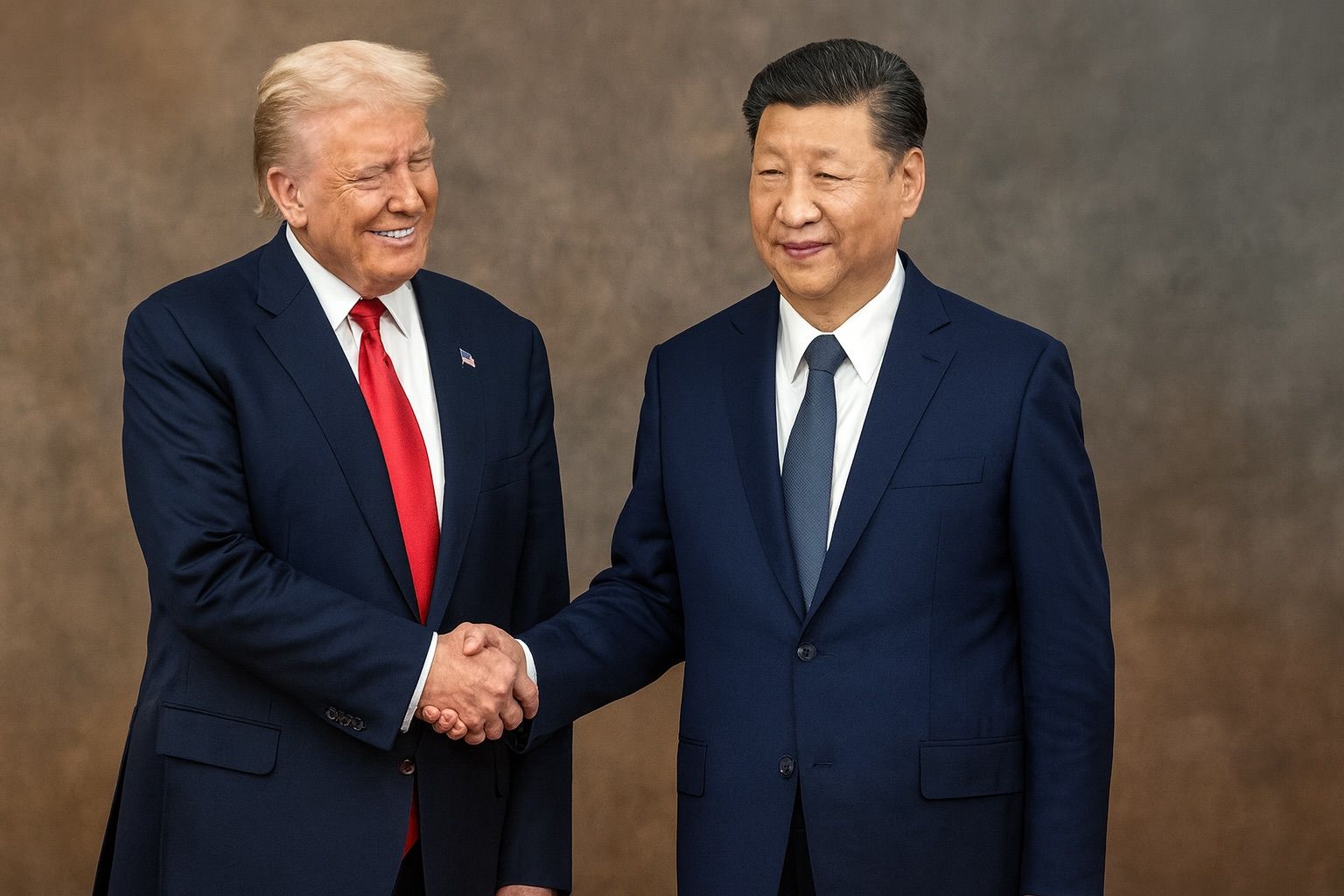- Trade Truce Announced: On Oct. 30, Presidents Trump and Xi agreed to a one-year “pause” in their tariff war. China will defer new rare-earth export controls for one year and resume buying U.S. soybeans and energy, while the U.S. will cut existing tariffs (e.g. halving its 20% fentanyl-related tariff to 10%) [1]. Top Chinese officials confirmed a one-year extension of the trade truce from Malaysian talks last week [2]. Both leaders hailed an “amazing” meeting – Trump promised to resume rare-earth supplies and huge U.S. soybean sales [3] – but many underlying issues (tech competition, Taiwan, permanent tariff reductions) remain unresolved [4] [5].
- Stocks Soar on Deal Hopes: Global markets had already rallied to fresh records in the days before the summit on the prospect of a deal. On Oct. 27, Wall Street stocks hit record closes (Dow ~47,545; S&P 500 ~6,875; Nasdaq ~23,637) on the optimistic news [6]. Tech shares led gains (e.g. Qualcomm up 11% on new AI chips) [7]. Lower inflation also fueled Fed-cut bets (the Fed delivered a 25 bps cut on Oct. 29) [8]. On Oct. 29 the Nasdaq closed at a new all-time high (23,958) as Nvidia briefly topped a $5 trillion market cap [9]. By Oct. 30, markets were more cautious: Hong Kong’s Hang Seng fell about 0.2% to ~26,283 and Shanghai’s Composite 0.7% to ~3,987, after earlier hitting decade highs [10] [11]. Wall Street futures dipped on mixed tech earnings and Fed caution [12].
- Key Sectors Affected: Technology and AI stocks initially jumped: Nvidia (+7%), AMD (+6.5%) and other chipmakers surged on deal optimism [13], lifting the Nasdaq. However, Trump did not win new Chinese exports of Nvidia’s latest AI chips [14]. Semiconductors could benefit long-term if rare-earth supplies remain steady; China agreed to pause its new rare-earth export curbs (critical for EVs and electronics) for a year [15]. Agriculture stocks saw relief: soybeans and corn prices rose as China vowed to buy large U.S. soybean quantities [16] [17]. Automotive and clean energy firms may get a boost from steadier rare-earth and LNG flows (China hinted it will begin major U.S. energy purchases) [18]. Energy/export industries will watch the planned $44 billion LNG deal. Other sectors (e.g. TikTok’s fate, ports fees) have only tentative resolutions [19] [20].
- Political Context: Crucial geopolitical issues were largely side-stepped. Trump and Xi did not discuss Taiwan or lift broad tech sanctions [21]. The truce is a tactical pause: China’s commerce ministry reiterated that only temporary measures (1-year tariff and export-control moratoriums) are agreed [22]. U.S. Senate Democrats were skeptical (Sen. Schumer called it “Trump folded on China” [23]). Chinese state media spun it as Xi’s victory. Notably, hours after the talks Trump announced resumption of long-paused U.S. nuclear testing – drawing fire from Beijing [24]. Analysts stress this truce is not a strategic reset: tech competition and high tariffs largely remain [25] [26].
- Global Market Impact:Global stocks rallied broadly on deal hopes. MSCI’s world index hit a record intraday high on Oct. 27 [27], and Europe’s STOXX 600 also climbed to new peaks [28]. Safe havens tumbled (gold fell ~2%, USD weakened) as risk appetite spiked [29] [30]. Commodities like soy and corn jumped on expected Chinese buying [31]. By week’s end, however, gains were tempered. In Asia, Nikkei 225 was flat, Hong Kong’s Hang Seng was slightly down [32], and Australian/Southeast markets were mixed ahead of central bank meetings. Canada’s TSX edged up ~0.3% on Oct. 30, led by tech/materials, as investors recalibrated Fed-cut odds alongside the China news [33].
- Analysts’ Take & Forecast: Experts warn the rally may be muted or temporary. Saxo’s Charu Chanana calls it a “risk‑managed trading” rally rather than a full-on bull run [34]. William Buck’s Besa Deda notes the cautious market response – Asian equities dipped on the news – saying many structural problems (tech blocks, ongoing high tariffs) remain [35]. MUFG’s Marco Sun and others see it as a “tactical pause” [36] [37]. OCBC’s Vasu Menon highlights the need for follow-through: we’ll need to see real action and stability before confidence returns [38]. Economists also point out that tariffs are still much higher than pre-trade-war levels: Morgan Stanley’s Michael Gapen says the detente “locks in” a slow-growth, sticky-inflation scenario since the effective U.S. tariff rate remains around ~13% (vs ~2% before) [39]. A Reuters poll found many economists see only marginal improvement to U.S. growth from this brief truce [40].
- Outlook: In the short term, the deal eases uncertainty: some “buy the dip” strategists (e.g. Goldman Sachs) remain upbeat into year-end [41]. Investors will watch if U.S. and China honor the truce and the Fed’s policy moves. With Fed Chair Powell cautious on further cuts, markets may settle into a wait-and-see mode. If China follows through on purchases and rare-earth exports remain open, affected sectors could see a modest boost. However, many analysts emphasize that true reset of U.S.-China tensions will require deeper resolution of issues like technology access and permanent tariff cuts, not just an annual truce [42] [43]. For now, Wall Street and global bourses have enjoyed a relief rally on the deal [44] [45], but caution is advised: as Dixon Wong quips, investors must see if an “anticlimax” doesn’t follow this honeymoon phase [46].
Sources: Latest reports from Reuters, Al Jazeera, TS2.tech and other media [47] [48] [49] [50].
References
1. www.aljazeera.com, 2. www.businesstimes.com.sg, 3. www.aljazeera.com, 4. www.reuters.com, 5. www.reuters.com, 6. ts2.tech, 7. ts2.tech, 8. ts2.tech, 9. ts2.tech, 10. www.reuters.com, 11. www.businesstimes.com.sg, 12. ts2.tech, 13. ts2.tech, 14. www.reuters.com, 15. www.reuters.com, 16. www.reuters.com, 17. ts2.tech, 18. www.reuters.com, 19. www.reuters.com, 20. www.reuters.com, 21. www.reuters.com, 22. www.reuters.com, 23. www.reuters.com, 24. www.reuters.com, 25. www.reuters.com, 26. www.reuters.com, 27. ts2.tech, 28. ts2.tech, 29. ts2.tech, 30. ts2.tech, 31. ts2.tech, 32. www.reuters.com, 33. www.reuters.com, 34. www.reuters.com, 35. www.reuters.com, 36. www.reuters.com, 37. www.reuters.com, 38. www.reuters.com, 39. www.reuters.com, 40. www.reuters.com, 41. ts2.tech, 42. www.aljazeera.com, 43. www.reuters.com, 44. ts2.tech, 45. www.reuters.com, 46. www.reuters.com, 47. ts2.tech, 48. www.reuters.com, 49. www.aljazeera.com, 50. www.reuters.com
